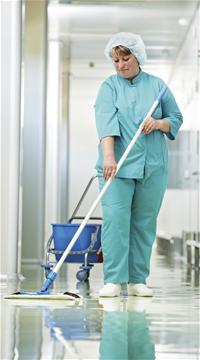BOSTON — A movement is afoot to detoxify hospital cleaning by implementing "green" cleaning practices and several ministry members are among its proponents.
 "The Environmental Protection Agency notes that thousands of chemicals and biological pollutants are found indoors, which can lead to numerous health problems including kidney and central nervous system damage," said Nancy Mulvihill, vice president of corporate communications at Covenant Health Systems in Tewksbury, Mass. "Using green cleaning products demonstrates not only respect for the environment but also respect for the workers who are exposed to them," said Mulvihill. She has headed Covenant's environmental committee since 2004.
"The Environmental Protection Agency notes that thousands of chemicals and biological pollutants are found indoors, which can lead to numerous health problems including kidney and central nervous system damage," said Nancy Mulvihill, vice president of corporate communications at Covenant Health Systems in Tewksbury, Mass. "Using green cleaning products demonstrates not only respect for the environment but also respect for the workers who are exposed to them," said Mulvihill. She has headed Covenant's environmental committee since 2004.
Covenant's environmentally preferred purchasing policy is intended to eliminate the use of products containing certain targeted chemicals linked to cancer; and, whenever possible, Covenant utilizes greener chemicals and equipment for cleaning and maintenance processes. It also is transitioning to safer sterilants and disinfectants, Mulvihill said.
"Concentrated formulations, precise dispensing systems, group purchasing discounts and value-added product training offered by suppliers and distributors help to contain and control costs — dispelling the misperception that green products always cost more," she said.
While controlling supply costs is important to Covenant, the system's sustainability initiatives are driven by the mission of Catholic health ministry. "As health care professionals, we are compelled to ÔFirst, do no harm.' And as neighbors both locally and globally, we are called upon to act in the best interest of our communities," Mulvihill said.
Sr. Mary Ellen Leciejewski, OP, director of ecology for San Francisco-based Dignity Health, said that system is buying more green cleaning products.
Sr. Leciejewski said that in addition to damaging the environment, toxic chemicals may pose a particular risk for patients with compromised immune systems and to small children, who, pound-for-pound, eat, breathe, and drink more than adults and take in more toxins in the process.
Finding safer alternatives reflects the system's values of stewardship and excellence, she said. "To purchase products that have the safest impact on the environment so that we have something safe to pass on to our kids, that is excellent health care," she said.
CleanMed
Cecilia DeLoach Lynn is director of facility engagement and metrics for Practice Greenhealth, a nonprofit membership organization for health care organizations committed to sustainable practices and reducing their environmental footprint. The organization's annual CleanMed meeting drew over 900 participants to Boston in April, where they could attend several sessions on green cleaning products and methods. In an interview there DeLoach Lynn said that sustainable or green cleaning practices are those that support infection prevention and control while also protecting patients, staff and the environment from the risks posed by toxic cleaning materials and processes.
During a pre-conference session on environmentally preferable cleaning practices in health care, researchers said there are real health concerns for clinicians and frontline workers, such as the potential for increased rates of work-related asthma as well as exposure levels that may surpass Occupational Safety and Health Administration limits for some chemicals. The research also suggests that health care staff will benefit from a reduction in the use of toxic cleaning agents in hospitals, but further studies are needed to document the potential benefits.
DeLoach Lynn said that traditional cleaning products present a variety of human health and ecological concerns and can contribute to poor indoor air quality. Some cleaning agents contain chemicals that cause cancer, reproductive disorders, respiratory ailments, eye and skin irritation, central nervous system impairment, and other human health effects.
Nurses, environmental services and housekeeping workers are routinely exposed to a combination of cleaning products, making it difficult to determine the "true culprit" of health impacts at times, DeLoach Lynn said.
Quality cleaning
DeLoach Lynn said green cleaning encompasses a broad set of practices and is not about simply switching one product for another. A successful program is focused on overall "quality cleaning" — including standardized operations, effective tools and cleaning chemicals, dispensing systems that uniformly measure and mix cleaning concentrates and water, comprehensive staff training, proper protective equipment and clearly written policies and protocols for the various levels of cleaning, including response to biohazards such as blood and bodily fluid spills. Many hospitals are reexamining their cleaning product choices at the same time they are reviewing their cleaning programs and laying out new processes to ensure cleaning effectiveness. She said it is critical to involve the infection prevention team when considering any product transition.
Janet Brown, director of facility engagement for Practice Greenhealth, also directs content and outreach for the Healthier Hospitals Initiative. The initiative was developed by Practice Greenhealth in collaboration with two other nonprofit, health care improvement collaboratives — Health Care Without Harm and The Center for Health Design. Dignity Health, Bon Secours Health System, and Catholic Health Initiatives are three of the initiative's founding members. Many other ministry organizations as well as many secular and for-profit members have joined the initiative since it was launched in April 2012. Their commitment includes focus on selecting less toxic cleaning products particularly for carpet cleaners, general purpose cleaners, bathroom cleaners and glass cleaners.
"Green cleaning is an area of proven success," Brown said. "By choosing to use cleaning products that have received third party certification from GreenSeal or EcoLogo for being safer for workers, and more environmentally friendly, it's easier for hospitals to reduce the toxicity of their cleaning protocol and improve air quality for staff and patients, often without increasing cost."
Brown also noted that increasingly, contracted service providers are also choosing to use "greener cleaners," making it less challenging for hospitals to make the transition.
